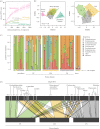Distinctive fungal communities in an obligate African ant-plant mutualism
- PMID: 28298347
- PMCID: PMC5360918
- DOI: 10.1098/rspb.2016.2501
Distinctive fungal communities in an obligate African ant-plant mutualism
Abstract
Three ant species nest obligately in the swollen-thorn domatia of the African ant-plant Vachellia (Acacia) drepanolobium, a model system for the study of ant-defence mutualisms and species coexistence. Here we report on the characteristic fungal communities generated by these ant species in their domatia. First, we describe behavioural differences between the ant species when presented with a cultured fungal isolate in the laboratory. Second, we use DNA metabarcoding to show that each ant species has a distinctive fungal community in its domatia, and that these communities remain characteristic of the ant species over two Kenyan sampling locations separated by 190 km. Third, we find that DNA extracted from female alates of Tetraponera penzigi and Crematogaster nigriceps contained matches for most of the fungal metabarcodes from those ant species' domatia, respectively. Fungal hyphae and other debris are also visible in sections of these alates' infrabuccal pockets. Collectively, our results indicate that domatium fungal communities are associated with the ant species occupying the tree. To the best of our knowledge, this is the first record of such ant-specific fungal community-level differences on the same myrmecophytic host species. These differences may be shaped by ant behaviour in the domatia, and by ants vectoring fungi when they disperse to establish new colonies. The roles of the fungi with respect to the ants and their host plant remain to be determined.
Keywords: Tetraponera; Vachellia (Acacia) drepanolobium; fungi; insects; metabarcoding; species interactions.
© 2017 The Author(s).
Figures



References
-
- Stanton ML, Palmer TM, Young TP, Evans A, Turner ML. 1999. Sterilization and canopy modification of a swollen thorn acacia tree by a plant-ant. Nature 401, 578–581. (10.1038/44119) - DOI
-
- Martins DJ. 2010. Not all ants are equal: obligate acacia ants provide different levels of protection against mega-herbivores. Afr. J. Ecol. 48, 1115–1122. (10.1111/j.1365-2028.2010.01226.x) - DOI
MeSH terms
LinkOut - more resources
Full Text Sources
Other Literature Sources
Medical

